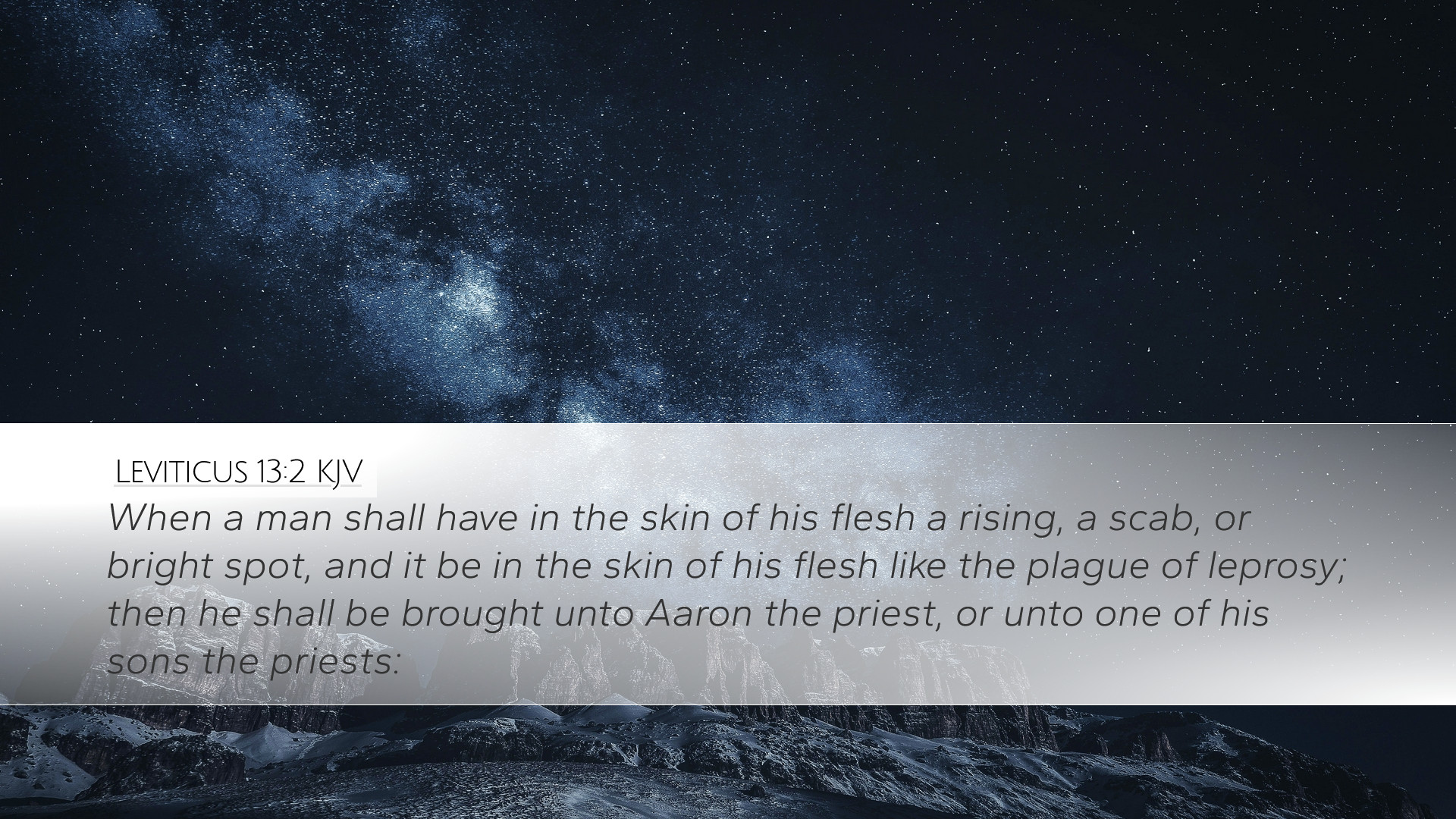Bible Commentary on Leviticus 13:2
Verse Overview: Leviticus 13:2 presents the initial instructions regarding the condition of leprosy, detailing the criteria by which a person could be deemed ceremonially unclean. This verse serves as a critical point for understanding the law of purity in the Old Testament.
Text of the Verse
The verse reads: “When a man shall have in the skin of his flesh a rising, a scab, or a bright spot, and it be in the skin of his flesh like the plague of leprosy; then he shall be brought unto Aaron the priest, or unto one of his sons the priests.”
Exegesis and Commentary
Contextual Background
Leviticus as a Holiness Code: The book of Leviticus is fundamental for the priestly regulations concerning holiness, purity, and the sacrificial system established for the nation of Israel. In this context, the health matters discussed in chapter 13 address the broader issue of cleanliness that is vital for living in accordance with God’s covenant.
The Role of the Priest
Priesthood and Community Health: The calling of priests, notably Aaron and his sons, involved the discernment of physical ailments that affected one’s purity. The necessity of bringing suspected cases to the priest underscores the community’s reliance on spiritual authorities for guidance in maintaining holiness.
Criteria of the Leprosy Diagnosis
- “Rising, a scab or a bright spot”: These terms denote variations in skin diseases that might indicate the presence of a deeper spiritual or physical issue.
- The Terminology: The Hebrew terms used here convey a sense of observation and scrutiny, as the priest was responsible for examining the individual thoroughly.
Symbolism and Theological Implications
Leprosy as a Symbol: Leprosy symbolically represents sin and its corrupting influence. Just as leprosy eats away at the body, sin can corrode the soul and lead one away from communal and divine relationship.
The Process of Identification
Bring to the priest: The act of presenting oneself to the priest for examination exemplifies humility and acknowledgment of one’s condition. This suggests a broader theological principle: the need for confession and accountability within the community of faith.
Faithfulness and Obedience
In referring to the priestly intervention, the verse calls for the faithful obedience of the Israelites, recognizing that health is a community concern as well as a personal one.
Insights from Historical Commentators
Matthew Henry's Perspective
Congregational Care: Matthew Henry emphasizes the necessity of communal consideration for health and spiritual well-being. He asserts that the priests played a vital role not merely as medical examiners but as spiritual leaders guiding the community towards wholeness.
Albert Barnes’ Observations
Natural and Ceremonial Law: Barnes elucidates on how the condition of leprosy (tsaraath) in this verse serves dual purposes, functioning as both a physical ailment and a ceremonial concern. He highlights the importance of the priest’s role in restoring individuals to the community after diagnosis.
Adam Clarke’s Analysis
Public Health and Holiness: Clarke discusses the aspect of public health provided within this legislation, arguing that God’s laws served to maintain societal health and purity. He sees in this verse a prescriptive framework for community responsibilities in spiritual matters.
Application for Contemporary Readers
Spiritual Health: For modern pastors and theologians, the principles derived from Leviticus 13:2 can be extended to the notion of spiritual health in the church. It challenges leaders to engage in pastoral care with an emphasis on identifying spiritual maladies within their congregations.
Call to Accountability
This verse invites believers to seek accountability and support within their communities to address personal and collective sin, emphasizing the need for ongoing spiritual discernment and confession.
The Importance of Church Authority
Realizing the role of church leadership in assessing spiritual conditions encourages a healthier relationship between the laity and the clergy, promoting unity and mutual responsibility.
Conclusion
Leviticus 13:2 provides a significant foundational insight into the intersection of faith, health, and community. The careful attention to physical conditions serves as a mirror for examining the spiritual conditions faced by the church today, encouraging ongoing reflection, repentance, and restoration. Such themes resonate powerfully within the pastoral and theological discourse, prompting both historical awareness and contemporary application.


